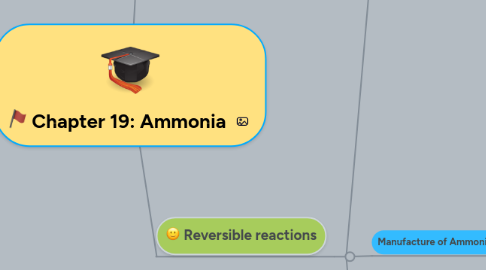
1. Irreversible reactions
1.1. Proceed in only 1 drection
1.2. Frying an Egg
2. Reversible reactions
2.1. Go both Forward and Backward at the Same Time
2.2. Manufacture of Ammonia
2.2.1. Haber Process
2.2.1.1. Raw Nitrogen and Hydrogen are mixed in the portion of 1:3
2.2.1.2. Done under the conditions of High Pressure, Relative High Temperature and Iron as a catalyst to Speed up Rate of reaction
2.2.1.3. Lower the Temperature, Higher the Yield of Ammonia
2.2.1.3.1. Decomposition of Ammonia into Hydrogen gas and Nitrogen gas is reduced
2.2.1.3.2. Lower Temperature results in slower reaction
2.2.1.4. Higher the Pressure, Higher the Yield of Ammonia
2.2.1.4.1. High Pressure increases the speed of reaction
2.2.1.4.2. maintaining high pressure is costly
2.2.1.4.3. pressure applied has limits
2.2.1.5. Finely divided Iron instead of a Block of Iron for Catalyst
2.2.1.5.1. smaller particles of finely divided iron provides a bigger surface area for reaction to take place, hence faster speed of reaction
2.2.1.6. Optimal Conditions of 250 atm, 450*c, and finely divided Iron as catalyst
2.2.2. Uses of Ammonia
2.2.2.1. Fertiliser
2.2.2.2. Cleaning agents
2.2.2.3. Explosives
2.2.3. Implications
2.2.3.1. Quicklime (CaO) and Calcium Hydroxide (CaOH) are added to neutralize the acidity in soil
2.2.3.1.1. reacts with nitrogenous fertilizers to form ammonia gas, which escapes into the atmosphere
2.2.3.1.2. loss in nitrogen from the fertilizers, leading to a wastage

